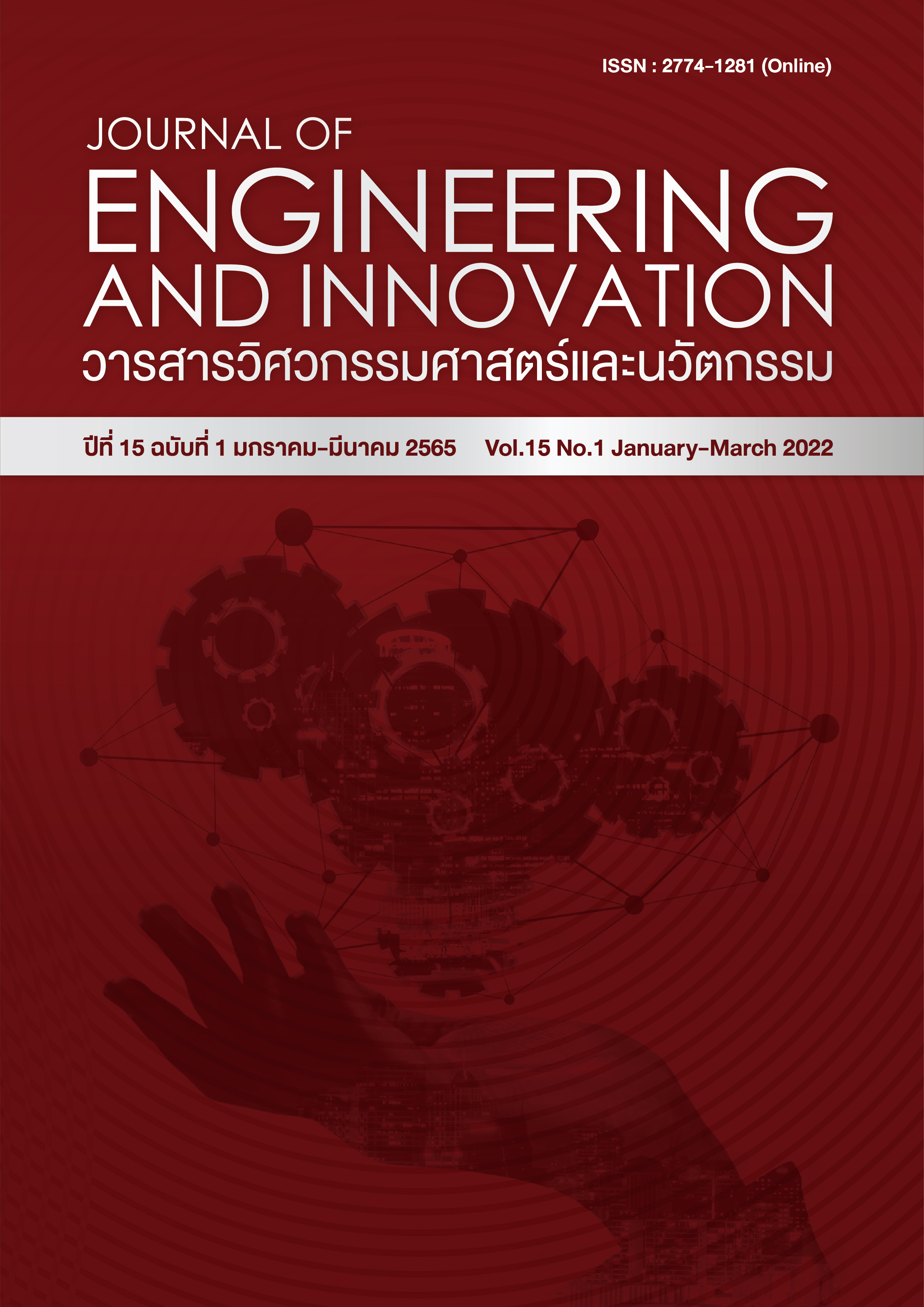Enhancement the power coefficient of a vertical axis wind turbine with curved surface hole
Main Article Content
Abstract
The energy efficiency of vertical axis wind turbines is often limited by the air resistance behind the turbine blades. This research was conducted to decrease the drag coefficient (Cd) of the blades with the curved surface hole method. The blade made from mild steel with 1.5 mm of thickness while the ratio of height to length (h/b) is 2.0. A 25 mm ball steel used to press for the curved surface hole on the back of blade with three rows in longitudinal. There are four types of blade for used in the experimental. That the radius of curved surface holes of 0.25R, 0.5R, 0.75R and 1.0R. Experiments to determine the drag coefficient of turbine blades and energy efficiency of two-blade vertical axis wind turbines. Experiment within the wind tunnel with constant wind speed between 2.5 to 9.0 m/s. The results showed that the curved surface hole on the back of the blades reduced the drag coefficient of 1.12 while the turbine energy efficiency increased to 29% with the curved surface pits of 0.5R.
Article Details
References
[2] Ben FB, Robert ES and Louis VF. Wind tunnel performance data for two- and three-bucket Savonius rotors. National Technical Information Service, U. S. Department of Commerce; 1977.
[3] Pope K, Rodrigues V, Doylea R, Tsopelas A, Gravelsins R, Naterer GF and Tsang E. Effects of stator vanes on power coefficients of a zephyr vertical axis wind turbine. Renewable Energy. 2010;35: 1043-1051.
[4] Qasim AY, Usubamatov R, and Zain ZM. Investagation and design impeller type vertical axis wind turbine. Aust. J. Basic & Appl. Sci. 2011; 5 (12): 121–126.
[5] Priegue L and Stoesser T. The influence of blade roughness on the performance of a vertical axis tidal turbine. International Journal of Marine Energy. 2017;17: 136–146.
[6] Ramadan A, Yousef K, Said M and Mohamed MH. Shape optimization and experimental validation of a drag vertical axis wind turbine. Energy. 2018;151: 839–853.
[7] Saad AS, El-Sharkawy II, Ookawara S and Ahmed M. Performance enhancement of twisted-bladed savonius vertical axis wind turbines. Energy Conversion and Management. 2020;209: 1–19.
[8] Saad AS, Elwardany A, El-Sharkawy II, Ookawara S and Ahmed M. Performance evaluation of a novel vertical axis wind turbine using twisted blades in multi-stage Savonius rotors. Energy Conversion and Management. 2021;235: 1–21.
[9] ลัทธวรรณ นิยมธรรม, จอมภพ แววศักดิ์ และ ชนะ จันทร์ฉ่ำ. การประเมินศักยภาพของพลังงานลมด้วยระเบียบวิธีแผนที่ลมมหภาค: กรณีศึกษาพื้นที่ตอนกลางของประเทศไทย. วารสารมหาวิทยาลัยทักษิณ. 2563;23(1): 39–48.
[10] พนิดา สุขสมพร้อม, เกียรติฟ้า ตั้งใจจิต และ ศิโรรัตน์ พัฒนไพโรจน์. การศึกษาศักยภาพในการผลิตไฟฟ้าจากพลังงานลมสำหรับจังหวัดนครพนม. วิศวสารลาดกระบัง. 2563;37(2): 1–9.
[11] มนตรี เลื่องชวนนท์ และ กิจจา ศรีทองกุล. การออกแบบกังหันลมแนวแกนตั้งสำหรับความเร็วลมตํ่าในประเทศไทย. Thai Journal of Physics. 2563;37(1): 1–10.
[12] วีระศักดิ์ ไชยชาญ, ศักราช ทองนอก, เพียรดี อ่อนยิ่ง และ ภูเทพ วรรณบวร. การออกแบบอุปกรณ์ปรับมุมใบกังหันลมผลิตไฟฟ้าชนิดแกนแนวตั้ง 6 ใบพัด. วารสารวิจัยมหาวิทยาลัยเทคโนโลยีราชมงคลศรีวิชัย. 2561;10(1): 13–23.
[13] พรเทพ สุรมาตย์ และ ปรีชา เกรียงกรกฎ. การเปรียบเทียบประสิทธิภาพแบบจำลองแพนอากาศในกังหันลมเพลาตั้ง ชนิด Lenz II ในอุโมงค์ลมจำลองโดยใช้การออกแบบการทดลอง. เอกสารสืบเนื่องจากการประชุมวิชาการ มอบ. วิจัย ครั้งที่ 6; 25-27 กรกฎาคม 2555. หน้า 326–335.
[14] พงษ์พันธุ์ ฤกษ์ขุมทรัพย์, จรัสศรี เสือทับทิม และ ปฏิภาณ อร่ามวาณิชย์. การออกแบบและสร้างกังหันลมแนวตั้งขนาดกระทัดรัด. วารสารวิชาการปทุมวัน. 2560;7(19): 59–67.
[15] บุญญฤทธิ์ วังงอน. กังหันลมผลิตกระแสไฟฟ้าจากลมร้อนเครื่องปรับอากาศแบบแยกส่วน. วารสารวิจัยราชมงคลกรุงเทพ. 2560;11(1): 47–54.
[16] ธนาพล สุขชนะ. ผลกระทบของรูปทรงส่วนปลายใบแบบครึ่งทรงกระบอกต่อสมรรถนะของกังหันลมแบบแกนแนวตั้ง. วารสารวิศวกรรมศาสตร์ ราชมงคลธัญบุรี. 2562;17(1): 163–173.

